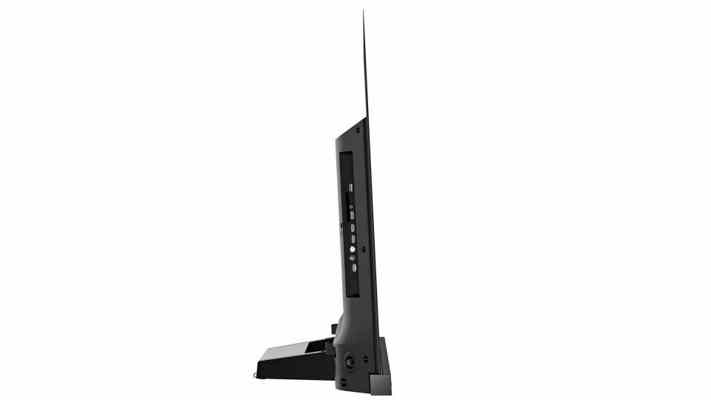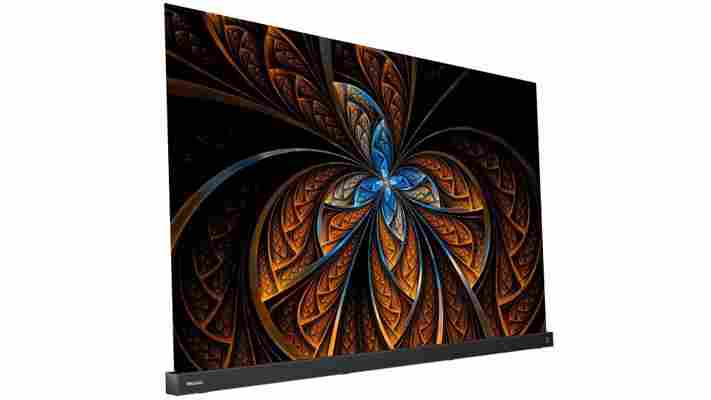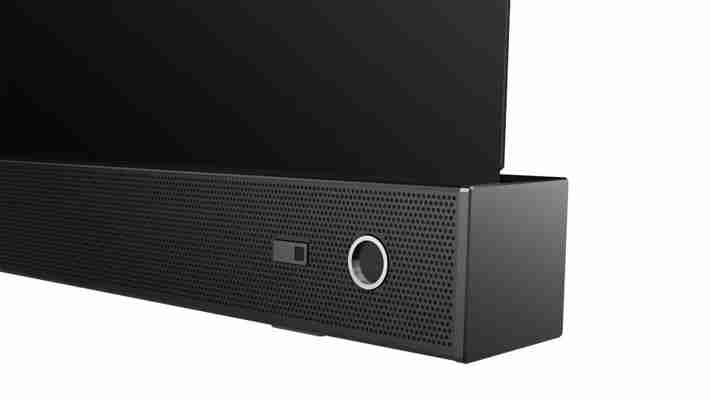Hisense A9G (55A9G) review: Great specs with last year’s looks
The Hisense A9G is the latest 4K HDR OLED TV from the Chinese manufacturer and comes feature-packed with Dolby Atmos, Dolby Vision IQ, HDR10+ and even IMAX Enhanced. The speakers sound surprisingly good, the smart platform works well and while there are a few minor issues, it's a very competitive package overall.
Buy now from Currys PC World
Hisense A9G OLED: Key specifications
Screen sizes available: 55in (55A9G), 65in (65A9G) Panel type: OLED Resolution: 4K/UHD (3,840 x 2,160) Refresh Rate: 120Hz HDR formats: Dolby Vision, HDR10, HDR10+, HLG Audio enhancements: Dolby Atmos HDMI inputs: HDMI 2.0 x 4 Streaming services: Netflix, Amazon Prime Video, Rakuten TV, YouTube, BBC iPlayer, ITV Hub, All 4, My5 Tuners: Terrestrial, Satellite Gaming features: ALLM, VRR (48-60Hz) Wireless connectivity: 802.11ac, Bluetooth 5.0 Smart platform: VIDAA U 5.0
Hisense A9G OLED review: What you need to know
The Hisense A9G is a 4K (3,840 x 2,160) HDR smart OLED TV that comes in 55in and 65in screen sizes – unlike several of its rivals, there are no compact 48-inch or big-screen 77-inch versions.
For this review Hisense has sent us the 55in Hisense 55A9G. And if you’re thinking that this TV’s name is rather familiar, then you’d be right: Sony’s 2019 4K OLED TV family also had a model called the A9G. Search for the Hisense, and you may find that Google throws up quite a few results for its Sony-branded namesake.
The Hisense A9G runs the latest version of the VIDAA U smart platform, and supports HDR10, HDR10+, Dolby Vision IQ and HLG. There’s also Dolby Atmos, IMAX Enhanced, and a decent selection of content streaming apps, plus Freeview Play, ensuring a full complement of TV catch-up services.
READ NEXT: The best streaming service to use
Hisense A9G OLED review: Price and competition
You can buy the 55in Hisense A9G for £1,799, while the 65in model will set you back £2,499. These prices compare favourably to much of the competition in 2021, especially when you consider all the features, but other manufacturers do offer more choice when it comes to screen sizes.
Sony’s entry-level A80 includes 55in (£1,899) and 65in (£2,699) models, and while it omits support for HDR10+, there are also 48in and 77in screen sizes. The LG B1 also doesn’t support HDR10+, and while there’s no 48in model, you do get a 77in (£3,599) version to go with the usual 55in (£1,599) and 65in (£2,399) screen sizes.
If you’re interested in LCD, the Samsung 4K Neo QLED QN85A is a good choice and offers 55in (£1,499), 65in (£2,499), 75in (£3,799) and 85in (£4,999) screen sizes. For bright room performance, LCD models still have a significant advantage over OLED, and make a great choice for gamers because there’s no danger of screen burn.
Hisense A9G OLED review: Design, connections and control
Not content with merely borrowing a previous Sony model number, Hisense also seems to have taken some design cues from earlier TVs made by the Japanese giant. The slight incline to the screen and large speaker bar along the bottom are both subtly reminiscent of Sony TVs from previous years.
As a result, while the A9G looks nice and is extremely well made, it also feels a bit dated in its appearance. In terms of dimensions, this 55in TV measures 1,234mm wide, 736mm high, and 279mm deep including the stand, and weighs in at a hefty 30.7kg.

The connections are on the left-hand side and most are side-facing, but unfortunately they’re only 10cm from the edge, which means cables can be visible. There are four HDMI 2.0 inputs (three side- and one rear-facing) with support for 4K at 60Hz, HDR, ALLM, VRR (48-60Hz only) and eARC. Bizarrely, the Hisense A9G is marketed as being an HDMI 2.1 TV despite not seeming to have any ports with a HDMI 2.1 bandwidth.
There are also terrestrial and satellite tuners, an AV input (adapter included), an optical digital output, an Ethernet port, two USB ports (2.0 and 3.0), a headphone socket, and a CI slot. In terms of wireless connections, you get built-in dual-band Wi-Fi and Bluetooth.
The remote is a classy affair, with a long, slim shape, and attractive black and silver two-tone finish. It’s comfortable to hold and easy to use with one hand. It’s well designed, too, with a sensible button layout and quick access buttons for the main streaming services, including Freeview Play.
READ NEXT: Best TV wall mount to buy
Hisense A9G OLED review: Smart TV platform
The Hisense A9G runs the latest version of the company’s VIDAA U smart platform (5.0), and while it isn’t as flashy or comprehensive as some of the competition, it remains an intuitive and effective system. It uses a full-screen home page that’s reminiscent of the latest version of Android, with all the apps, features, and information laid out in a fashion that’s easy to understand and navigate.
The apps appear along the centre of the home screen, and content related to the app currently highlighted is displayed just above. Beneath the apps are rows of content based on recommendations, while at the top are icons for searches, inputs, settings, recordings, and the EPG.
The interface is slick, customisable and easy to navigate thanks to the responsive remote control. The platform also has Amazon Alexa and Google Assistant support, which turns the A9G into a fully functioning smart assistant with voice control.
There’s a decent selection of streaming apps, including Netflix, Amazon Prime, YouTube, Britbox and Rakuten TV. There’s also Freeview Play, which not only means you get all the UK TV catch-up services, but also a well-integrated EPG. Only the absence of Disney+, Now, and Apple TV+ disappoints, but at least the inclusion of Dolby Vision and Atmos support makes the most of Netflix.
Buy now from Currys PC World
Hisense A9G OLED review: Image quality
The Hisense A9G uses an LG Display panel, just like every other OLED TV on the market, so it retains all the usual benefits, such as wider viewing angles, inky blacks, excellent shadow detail and highlights delivered with pixel precision. In addition, the overall screen uniformity is excellent, with no signs of banding, dirty screen effect or colour tinting.
The Cinema Night mode is the most accurate picture setting out of the box, with overall errors below the visible threshold. If you have the necessary meter, pattern generator and software, you can tweak the accuracy even more with the 2-point white balance control, but don’t be tempted to turn on the 20-point balance control: at the time of writing, it proves detrimental to image quality and needs to be fixed with a firmware update.

The gamma could be better, and the colour management system is a little crude, but overall the SDR picture performance is very good. The small town locales of Mare of Easttown look suitably natural, and even lower resolution content appears well-defined and detailed thanks to decent upscaling and processing that includes Hisense’s Alphonso AI-enhanced auto mode.
The A9G’s motion handling is generally very good, and the Ultra Smooth Motion menu offers a choice of smooth, standard, clear, film and custom. Film fans should leave all these off and avoid the film mode, which introduces judder, but sports fans might find the smooth mode works well, while the custom mode allows for experimentation with different judder and blur settings.
READ NEXT: The best TV deals this month
Hisense A9G OLED review: HDR performance
The Hisense A9G is a solid performer when it comes to high dynamic range, and offers a full suite of options – HDR10, HLG, HDR10+ and Dolby Vision IQ. There’s even IMAX Enhanced, although what value this mode adds remains to be seen because playing the IMAX Enhanced Bad Boys for Life didn't automatically select the mode, and when it is enabled, motion smoothing is toggled on by default.
For HDR10 and HLG, the Night mode is the most accurate option, but for HDR10+ the best choice is Cinema. With Dolby Vision choose the Dark setting for critical viewing, but the IQ setting uses a built-in light sensor to adjust picture brightness based on the dynamic metadata, and is useful when watching during the day. There’s also a Custom mode, but it seems redundant.
The A9G delivered a peak brightness of 570cd/m2 on a 10% window and 131cd/m2 on a full-field pattern, but the tone mapping did clip highlights on 4,000 and 10,000 nits content. However, for most content the results are excellent, with deep blacks and bright whites delivering punchy images.
The colour performance is also good, hitting 98% of the DCI-P3 colour space, which means you’re getting the full benefit of HDR’s wider colour gamut, and these colours are mapped correctly. As a result the TV handles the exaggerated colours that Pixar deliberately use during Inside Out’s more surreal moments with skill, producing a candy-coloured dream.
Buy now from Currys PC World
Hisense A9G OLED review: Gaming
The Hisense A9G is a reasonably good TV for gaming, but if you’re using one of the next-gen consoles you’ll be better served elsewhere. The HDMI 2.0 inputs support ALLM (automatic low latency mode), which means the TV switches into the game mode when a console is detected, but there’s no 4K at 120Hz and the VRR (variable refresh rate) is 48-60Hz only. The game mode uses the current picture setting but greys out features that increase input lag like motion enhancement.
While the lag is significantly lower in game mode, at 26.8ms it’s still a lot higher than most of the competition, many of whom offer a delay of less than 10ms. However, from our testing, gameplay with Horizon Zero Dawn in HDR on the PS4 was enjoyably responsive, with smooth motion, detailed images, and well-defined highlights. As always, there is a minimal risk of screen burn, but you’re unlikely to encounter issues if you watch a variety of content and don’t leave games paused for hours on end.
READ NEXT: The best gaming headset money can buy
Hisense A9G OLED review: Sound quality
The Hisense A9G sounds surprisingly good for a modern TV, especially when you consider it’s a thin OLED panel. Much of this sonic prowess comes down the speaker bar built into the bottom of the TV, which is combined with a subwoofer at the rear, and a pair of upward-firing speakers at the top. Add 100W of amplifier grunt and you’ve got a formidable 2.1.2-channel system.

The fact that the main channels are firing directly towards; the listener makes a big difference, with a clean and focused front soundstage. The A9G supports Dolby Atmos, and since there are actual upward-firing speakers the result is a genuine sense of front overhead channels. There’s also a decent amount of bass, even if it can’t compete with a soundbar and dedicated subwoofer.
There are a number of sound modes in the settings menu: Standard, Theatre, Music, Speech, Late Night, Sports, and Auto (when the Alphonso AI-enhanced viewing mode is turned on). These are all fairly self-explanatory, and make for a TV which sounds good straight out of the box.
Hisense A9G OLED review: Verdict
The Hisense A9G is an impressive 4K OLED TV that’s well-made and feature-packed. It’s not perfect of course, and while the picture accuracy is generally very good, the 20-point white balance is busted, the gamma is a bit wayward, and the HDR tone mapping can clip highlights in 4000/10000 nits content. There are also a few key apps like Disney+ missing, but otherwise this is a fine TV that’s definitely worth considering.
You’ll certainly struggle to find a similarly-priced model that supports Dolby Vision, HDR10+, IMAX Enhanced, and Dolby Atmos. Add in a 2.1.2-channel sound system, effective smart platform, and good overall performance with SDR and HDR, and the A9G really is a very competitive package.
Buy now from Currys PC World